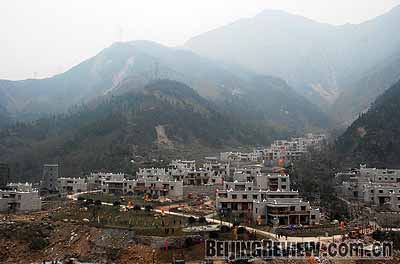|
At the southern end of Beichuan County, Sichuan Province, which was among the areas worst hit by the May 12 earthquake last year, there is a small ethnic Qiang village called Maoershi. Out of 71 households in the village, 69 collapsed in the 8.0-magnitude earthquake.
|

|
|
NEW HOME: Maoershi Village, a village of the Qiang ethnic group, promises to be a tourist destination in the near future (SHI GANG) | But just seven months later, 69 new buildings-with strong Qiang characteristics and more solid walls-stand at the original location, and 69 families have happily moved in just in time for the Spring Festival.
Regarded as the "southern gate" of Beichuan County, Maoershi sits on a hill along the only road to Beichuan. "Anyone who comes to Beichuan must pass by this village," said Zhang Anqing, head of the village.
Aside from its important geographic location, the village itself is unique in China. Rows of new, gray two-story buildings with white triangles dotting the roofs embody the strong flavor of the Qiang ethnic group. Many colorful flags with the character Qiang written on them flutter in the breeze. It is hard to imagine that a catastrophic earthquake hit this place just nine months ago. The village even has a new name: Jina Qiang Community. Jina is the name for the most beautiful goodness of the Qiang nationality.
In the west of the village, a watchtower, the typical construction of the Qiang ethnic group, is under construction, and the square in the center of the village is ready for use. There is even a library sponsored by charity organizations not far from the square with hundreds of books for villagers to read.
"It was in ruins when I went to Guang-dong Province to work in July last year, with tents lining the road. Now it has a completely new face," said Wang Liqiong, who came back for the Spring Festival in January.
Permanent home
The Qiang people, also called "the people living in the clouds" due to their high-altitude residence on the Qinghai-Tibet Plateau, have a history of at least 3,000 years. They number only about 300,000, and almost all of them live within 100 km of the epicenter. About 10 percent of the ethnic Qiang population was lost in the quake. Maoershi, famous for the Qiang people's unique stone castles and watchtowers, was a tourist attraction before the tremor. But its unique buildings were mostly destroyed.
Maoershi is the first village with permanent houses for the Qiang ethnic group after the earthquake. Since Beichuan County, the only Qiang autonomous county in China, was heavily damaged, preserving and developing Qiang culture is one of the government's top concerns.
Finally, the local government decided to make tourism its priority industry for future development. "We are training residents with different classes, including the history and culture of the Qiang group, the Qiang language and Qiang singing and dancing," said Zhang, "so that future life for local people will change from traditional agricultural life to mainly focus on service and tourism."
Jiang Chunhong moved into one of the new two-story buildings at the end of last December. Although her original house collapsed in the earthquake, fortunately none of her six family members was hurt. With the help of the local government, the new house was completed within five months.
|
